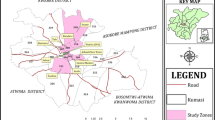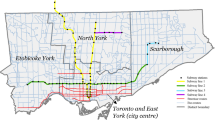Abstract
Airports play a crucial role in transportation, commerce, and tourism. They allow for efficient travel by air, connecting people and businesses to domestic and international destinations. Therefore, ground access to airports is a crucial aspect of the overall airport experience of passengers, and analysis of mode choice decisions by air passengers is a crucial part of managing and planning airport systems. Ground access to airports using ridesourcing services has recently gained popularity as a convenient and cost-effective alternative to traditional taxi and shuttle services. While private car uses for accessing airports have been studied systematically, further examination of the use of emerging ridesourcing services is needed. This study explores various options for ground access to Lokpriya Gopinath Bordoloi International (LGBI) Airport, Guwahati, India. The study also aims to identify the characteristics of available ground access modes and users, concentrating on the use of ridesourcing services and traditional taxi services. A binary logit model was created between ridesourcing and traditional taxi services to examine the choice of access mode. The results indicate that several factors, including residence status, age, luggage, convenience, availability, and prior information about the trip, were significant at 95% confidence level. Specifically, 30.5% of respondents used ridesourcing services to access the LGBI airport, while private vehicles and traditional taxi services accounted for 31.1% and 21% of mode share, respectively. The findings offer valuable information for improving transportation planning for accessing LGBI airport.


Similar content being viewed by others
References
Wattanacharoensil W, Schuckert M, Graham A (2016) An airport experience framework from a tourism perspective. Transp Rev 36(3):318–340. https://doi.org/10.1080/01441647.2015.1077287
Green RK (2007) Airports and economic development. Real Estate Econ 35(1):91–112. https://doi.org/10.1111/j.1540-6229.2007.00183.x
Florida R, Mellander C, Holgersson T (2015) Up in the air: the role of airports for regional economic development. Ann Reg Sci 54(1):197–214. https://doi.org/10.1007/s00168-014-0651-z
International Air Transport Association (2019) Global Aviation summit—India 2019. [Online]. Available: https://www.iata.org/en/iata-repository/publications/economic-reports/global-aviation-summit-india-2019/
Directorate General of Civil Aviation (2022). https://www.dgca.gov.in/digigov-portal/?page=jsp/dgca/InventoryList/dataReports/aviationDataStatistics/airTransport/domestic/airTraffic/Dec2022.pdf&main4264/4206/sericename
Airport Authority of India (2022) https://www.aai.aero/en/business-opportunities/aai-traffic-news
National Civil Aviation Policy (2016) [Online]. Available: http://www.civilaviation.gov.in/sites/default/files/Final_NCAP_2016_15-06-2016-2_1.pdf
Mandle PB, Mansel DM, Coogan MA (2000) Use of public transportation by airport passengers. Transp Res Rec J Transp Res Board 1703(1):83–89. https://doi.org/10.3141/1703-11
Sayan C For Ola and Uber, India’s shared taxi market is the next battleground. [Online]. Available: https://www.livemint.com/Companies/zurwJmatKucNvacjRmwxLK/Shared-rides-the-next-battleground-for-Ola-Uber.html
Dong X, Ryerson MS (2021) Taxi drops off as transit grows amid ride-hailing’s impact on airport access in New York. Transp Res Rec J Transp Res Board 2675(2):74–86. https://doi.org/10.1177/0361198120963116
S. Shaheen, N. Chan, A. Bansal, and A. Cohen, “Shared Mobility: A Sustainability & Technologies Workshop: Definitions, Industry Developments, and Early Understanding,” UC Berkeley, p. 30, 2015, [Online]. Available: https://escholarship.org/content/qt2f61q30s/qt2f61q30s.pdf
Susan Shaheen IZ, Cohen A (2016) Shared mobility: current practices and guiding principles. [Online]. Available: https://rosap.ntl.bts.gov/view/dot/42193
Wang Y, Shi W, Chen Z (2021) Impact of ride-hailing usage on vehicle ownership in the United States. Transp Res Part D Transp Environ 101(November):103085. https://doi.org/10.1016/j.trd.2021.103085
Ronald N, et al (2017) Mobility patterns in shared, autonomous, and connected urban transport. https://doi.org/10.1007/978-3-319-51602-8_16
Rayle L, Dai D, Chan N, Cervero R, Shaheen S (2016) Just a better taxi? A survey-based comparison of taxis, transit, and ridesourcing services in San Francisco. Transp Policy 45:168–178. https://doi.org/10.1016/j.tranpol.2015.10.004
2008b ACRP (2008) Airport ground access mode choice models. https://doi.org/10.17226/23106.
Ellis RH, Bennett JC, Rassam PR (1974) Approaches for improving airport access. Transp Eng J ASCE 100(3):661–673. https://doi.org/10.1061/TPEJAN.0000451
Harvey G (1986) Study of airport access mode choice. J Transp Eng 112(5):525–545. https://doi.org/10.1061/(ASCE)0733-947X(1986)112:5(525)
Monteiro AB, Hansen M (1996) Improvements to airport ground access and behavior of multiple airport system: BART extension to San Francisco International Airport. Transp Res Rec J Transp Res Board 1562:38–47. https://doi.org/10.3141/1562-05
Psaraki V, Abacoumkin C (2002) Access mode choice for relocated airports: the new Athens International Airport. J Air Transp Manag 8(2):89–98. https://doi.org/10.1016/S0969-6997(01)00033-3
Hess S, Polak JW (2006) Airport, airline and access mode choice in the San Francisco Bay area. Pap Reg Sci 85(4):543–567. https://doi.org/10.1111/j.1435-5957.2006.00097.x
Gupta S, Vovsha P, Donnelly R (2008) Air passenger preferences for choice of airport and ground access mode in the New York City metropolitan region. Transp Res Rec J Transp Res Board 2042(1):3–11. https://doi.org/10.3141/2042-01
Alhussein SN (2011) Analysis of ground access modes choice King Khaled International Airport, Riyadh, Saudi Arabia. J Transp Geogr 19(6):1361–1367. https://doi.org/10.1016/j.jtrangeo.2011.07.007
Pels E, Nijkamp P, Rietveld P (2003) Access to and competition between airports: a case study for the San Francisco Bay area. Transp Res Part A Policy Pract 37(1):71–83. https://doi.org/10.1016/S0965-8564(02)00007-1
Akar G (2013) Ground access to airports, case study: Port Columbus International Airport. J Air Transp Manag 30:25–31. https://doi.org/10.1016/j.jairtraman.2013.04.002
Gokasar I, Gunay G (2017) Mode choice behavior modeling of ground access to airports: a case study in Istanbul, Turkey. J Air Transp Manag 59:1–7. https://doi.org/10.1016/j.jairtraman.2016.11.003
Sabit R, Asmael N (2023) Exploring access modes to Baghdad International Airport. E3S Web Conf E3S(1):2. https://doi.org/10.1051/e3sconf/202340202006
Tam ML, Lam WHK, Lo HP (2011) The impact of travel time reliability and perceived service quality on airport ground access mode choice. J Choice Model 4(2):49–69. https://doi.org/10.1016/S1755-5345(13)70057-5
Budd T, Ryley T, Ison S (2014) Airport ground access and private car use: a segmentation analysis. J Transp Geogr 36:106–115. https://doi.org/10.1016/j.jtrangeo.2014.03.012
Anil Yazici M, Kamga C, Singhal A (2016) Modeling taxi drivers’ decisions for improving airport ground access: John F. Kennedy airport case. Transp Res Part A Policy Pract 91:48–60. https://doi.org/10.1016/j.tra.2016.06.004
Zaidan E, Abulibdeh A (2018) Modeling ground access mode choice behavior for Hamad International Airport in the 2022 FIFA World Cup city, Doha, Qatar. J Air Transp Manag 73(2018):32–45. https://doi.org/10.1016/j.jairtraman.2018.08.007
Jou RC, Hensher DA, Hsu TL (2011) Airport ground access mode choice behavior after the introduction of a new mode: a case study of Taoyuan International Airport in Taiwan. Transp Res Part E Logist Transp Rev 47(3):371–381. https://doi.org/10.1016/j.tre.2010.11.008
Cirillo C, Xu R (2010) Forecasting cybercar use for airport ground access: case study at Baltimore Washington International Airport. J Urban Plan Dev 136(3):186–194. https://doi.org/10.1061/(asce)up.1943-5444.0000018
Dong X, Ryerson MS (2020) Taxi drops off as transit grows amid ride-hailing’s impact on airport access in New York. Transp Res Rec 2675(2):74–86. https://doi.org/10.1177/0361198120963116
National Remote Sensing Centre (2022) Bhuvan-Indian Geoplatform of ISRO. Open Data Archieves—Cartosat 1. https://bhuvan.nrsc.gov.in/home/index.php
William G. Cochran, Sampling Techniques. [Online]. Available: https://hwbdocuments.env.nm.gov/LosAlamosNationalLabs/General/14447.pdf
Ministry of Road Transport and Highways, India. https://morth.nic.in/annual-report
Federal Highway Administration. https://www.fhwa.dot.gov/policyinformation/statistics/2020/mv1.cfm
Census India. https://censusindia.gov.in/census.website/
Mamdoohi AR, Saffarzade M, Taherpour A, YazdanPanah M (2012) Modeling air passengers’ ground access mode choice a case study of IKIA. Int J Model Optim 2014:147–152. https://doi.org/10.7763/ijmo.2012.v2.101
Ben-Akiva SRL (1985) Discrete choice analysis theory and application to travel demand
Train KE (2009) Discrete choice methods with simulation, 2nd edn, vol. 9780521766. https://doi.org/10.1017/CBO9780511805271
Damodar N. Gujrati, Basic Econometrics, 5th ed. 2009. [Online]. Available: http://196.190.117.157:8080/jspui/bitstream/123456789/96/1/BasicEconometrics.pdf
McFadden D (1974) The measurement of urban travel demand. J Public Econ 3(4):303–328. https://doi.org/10.1016/0047-2727(74)90003-6
Simon HA (1966) Theories of decision-making in economics and behavioural science. In: Surveys of economic theory. Palgrave Macmillan UK, London, pp 1–28. https://doi.org/10.1007/978-1-349-00210-8_1
Acknowledgements
I would like to express my heartfelt gratitude to the Department of Civil Engineering, National Institute of Technology (NIT), Silchar, and the Lokpriya Gopinath Bordoloi Airport authorities for granting us permission to perform a survey. Their cooperation and support have been invaluable in enabling us to carry out our research effectively.
Funding
The authors did not receive support from any organization for the submitted work.
Author information
Authors and Affiliations
Corresponding author
Ethics declarations
Conflict of interest
The authors declare that they have no conflict of interest.
Ethical approval
The research presented in the manuscript titled “Understanding Ground Access Dynamics at Lokpriya Gopinath Bordoloi International Airport, Guwahati: A Case Study Analysis” has been conducted in strict adherence to the ethical standard.
Informed consent
Informed consent procedures were integral to our ethical framework. Participants were provided with comprehensive information regarding the study, including its purpose, procedures and benefits of research.
Rights and permissions
Springer Nature or its licensor (e.g. a society or other partner) holds exclusive rights to this article under a publishing agreement with the author(s) or other rightsholder(s); author self-archiving of the accepted manuscript version of this article is solely governed by the terms of such publishing agreement and applicable law.
About this article
Cite this article
Swami, L., Ahmed, M.A. & Jena, S. Understanding ground access dynamics at Lokpriya Gopinath Bordoloi International Airport, Guwahati: a case study analysis. Innov. Infrastruct. Solut. 8, 333 (2023). https://doi.org/10.1007/s41062-023-01301-8
Received:
Accepted:
Published:
DOI: https://doi.org/10.1007/s41062-023-01301-8




